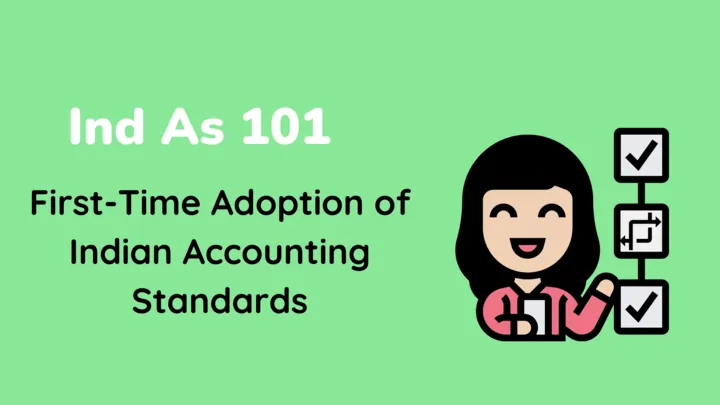Table of Contents
Ind AS 101, also known as the “First-time Adoption of Indian Accounting Standards,” provides guidance on how an entity should transition from its previous accounting framework to the Indian Accounting Standards (Ind AS). This standard is essential for companies in India as it ensures a smooth and consistent adoption of the new accounting principles. In this guide, we will explore the key aspects of Ind AS 101 and its implications for businesses.

Scope and Objective:-
The scope of Ind AS 101 covers entities that are required to adopt Ind AS for the first time. It outlines the guidelines and procedures for preparing and presenting the opening Ind AS balance sheet and the related disclosures. The objective is to ensure that the entity’s first Ind AS financial statements provide reliable and comparable information for users while facilitating a transparent transition from the previous accounting framework.
Opening Ind AS Balance Sheet:-
Ind AS 101 requires the preparation of an opening Ind AS balance sheet, which reflects the entity’s financial position as if it had always applied Ind AS. The transition date is typically the beginning of the earliest comparative period presented in the entity’s first Ind AS financial statements.
Mandatory Exceptions and Exemptions:-
The standard provides certain mandatory exceptions and exemptions to ease the transition process. These include exceptions related to the recognition and measurement of financial assets and liabilities, business combinations, and fair value measurement. Entities need to carefully assess and apply these exceptions based on their specific circumstances.
Recognition and Measurement of Financial Assets and Liabilities:-
Ind AS 101 provides certain exceptions for the recognition and measurement of financial assets and liabilities. Entities are allowed to designate financial assets and liabilities at their fair value on the date of transition to Ind AS, rather than at their original cost. This exception helps to align the financial statements with fair value measurements and improves the relevance of reported financial information.
Additionally, entities can opt for an exemption from applying Ind AS 109, “Financial Instruments,” retrospectively to past events. Instead, they can recognize any cumulative effect of applying Ind AS 109 on the opening balance sheet.
Business Combinations:-
Ind AS 101 offers exemptions related to business combinations. Entities are not required to apply Ind AS 103, “Business Combinations,” retrospectively to past business combinations that occurred before the date of transition to Ind AS. This exemption simplifies the transition process by avoiding the need to restate historical business combinations under the new accounting standards.
However, entities must disclose the aggregate effect of applying Ind AS 103 to business combinations that occurred after the date of transition. This disclosure provides users with relevant information about the impact of subsequent business combinations on the entity’s financial position.
Reconciliation and Disclosure Requirements:-
Ind AS 101 mandates the disclosure of significant adjustments made during the transition from the previous accounting framework to Ind AS. Entities are required to provide a detailed reconciliation between their previous financial statements and the opening Ind AS balance sheet. This reconciliation helps users understand the impact of the transition on key financial metrics.
Application of Ind AS in Subsequent Periods:-
Once an entity has successfully adopted Ind AS, it is required to apply the standards in subsequent reporting periods. This includes adhering to the recognition, measurement, and disclosure requirements specified by the relevant Ind AS.
Benefits and Challenges:-
The adoption of Ind AS through the framework provided by Ind AS 101 offers several benefits. It enhances financial reporting quality, transparency, and comparability, which in turn improves investor confidence. Ind AS also aligns Indian accounting practices with global standards, facilitating easier international business transactions and investments.
However, the transition to Ind AS can present challenges for entities, such as the need for significant data gathering, process changes, and implementation of new accounting policies. Entities may also encounter complexities in assessing the impact of Ind AS on various financial statement elements and addressing any gaps or inconsistencies between the previous accounting framework and Ind AS requirements.
Conclusion:-
Ind AS 101 plays a pivotal role in ensuring a smooth and standardized adoption of Indian Accounting Standards. By following the principles and requirements outlined in this standard, entities can transition to Ind AS effectively, providing reliable and comparable financial information to users. It is essential for entities to understand the scope, key principles, and challenges associated with Ind AS 101 to successfully navigate the transition process and realize the benefits of adopting Ind AS.